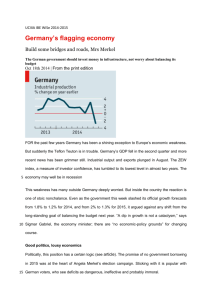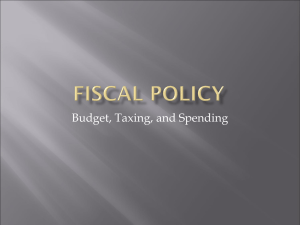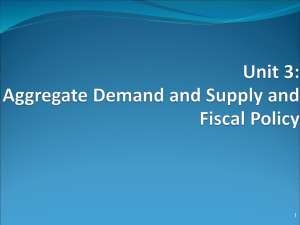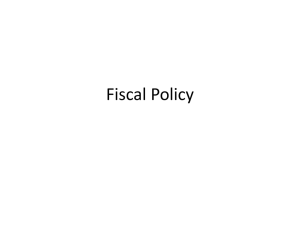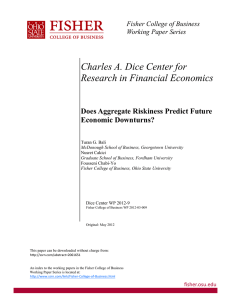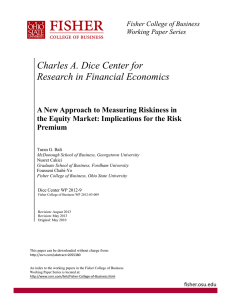J. Bradford DeLong 6 April 2012
advertisement
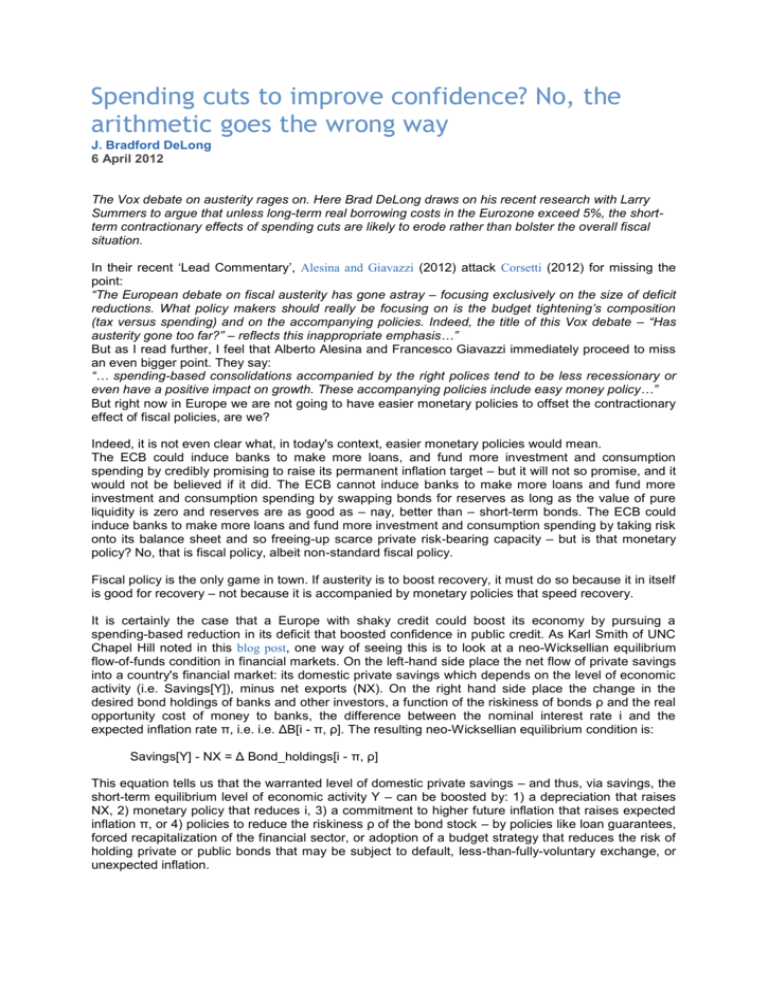
Spending cuts to improve confidence? No, the arithmetic goes the wrong way J. Bradford DeLong 6 April 2012 The Vox debate on austerity rages on. Here Brad DeLong draws on his recent research with Larry Summers to argue that unless long-term real borrowing costs in the Eurozone exceed 5%, the shortterm contractionary effects of spending cuts are likely to erode rather than bolster the overall fiscal situation. In their recent ‘Lead Commentary’, Alesina and Giavazzi (2012) attack Corsetti (2012) for missing the point: “The European debate on fiscal austerity has gone astray – focusing exclusively on the size of deficit reductions. What policy makers should really be focusing on is the budget tightening’s composition (tax versus spending) and on the accompanying policies. Indeed, the title of this Vox debate – “Has austerity gone too far?” – reflects this inappropriate emphasis…” But as I read further, I feel that Alberto Alesina and Francesco Giavazzi immediately proceed to miss an even bigger point. They say: “… spending-based consolidations accompanied by the right polices tend to be less recessionary or even have a positive impact on growth. These accompanying policies include easy money policy…” But right now in Europe we are not going to have easier monetary policies to offset the contractionary effect of fiscal policies, are we? Indeed, it is not even clear what, in today's context, easier monetary policies would mean. The ECB could induce banks to make more loans, and fund more investment and consumption spending by credibly promising to raise its permanent inflation target – but it will not so promise, and it would not be believed if it did. The ECB cannot induce banks to make more loans and fund more investment and consumption spending by swapping bonds for reserves as long as the value of pure liquidity is zero and reserves are as good as – nay, better than – short-term bonds. The ECB could induce banks to make more loans and fund more investment and consumption spending by taking risk onto its balance sheet and so freeing-up scarce private risk-bearing capacity – but is that monetary policy? No, that is fiscal policy, albeit non-standard fiscal policy. Fiscal policy is the only game in town. If austerity is to boost recovery, it must do so because it in itself is good for recovery – not because it is accompanied by monetary policies that speed recovery. It is certainly the case that a Europe with shaky credit could boost its economy by pursuing a spending-based reduction in its deficit that boosted confidence in public credit. As Karl Smith of UNC Chapel Hill noted in this blog post, one way of seeing this is to look at a neo-Wicksellian equilibrium flow-of-funds condition in financial markets. On the left-hand side place the net flow of private savings into a country's financial market: its domestic private savings which depends on the level of economic activity (i.e. Savings[Y]), minus net exports (NX). On the right hand side place the change in the desired bond holdings of banks and other investors, a function of the riskiness of bonds ρ and the real opportunity cost of money to banks, the difference between the nominal interest rate i and the expected inflation rate π, i.e. i.e. ΔB[i - π, ρ]. The resulting neo-Wicksellian equilibrium condition is: Savings[Y] - NX = Δ Bond_holdings[i - π, ρ] This equation tells us that the warranted level of domestic private savings – and thus, via savings, the short-term equilibrium level of economic activity Y – can be boosted by: 1) a depreciation that raises NX, 2) monetary policy that reduces i, 3) a commitment to higher future inflation that raises expected inflation π, or 4) policies to reduce the riskiness ρ of the bond stock – by policies like loan guarantees, forced recapitalization of the financial sector, or adoption of a budget strategy that reduces the risk of holding private or public bonds that may be subject to default, less-than-fully-voluntary exchange, or unexpected inflation. The only stimulus possible In a situation where an economy is at the zero lower bound so that i cannot be lowered, a central bank that will not raise π, and a common currency that rules out depreciation to raise NX, reducing the riskiness ρ of the bond stock is the only game in town. Now a credit-worthy government like the US would have no problem reducing the average riskiness ρ of the bond stock. It would simply issue more bonds and spend the money on projects of social utility. Because its credit is good, its bonds are automatically less risky than the average, and so the average riskiness of the bond stock falls. And a government with shaky credit that adopts a credible fiscal plan also has no problem reducing the average riskiness ρ of its bond stock. It adopts its plan. Its plan is credible. And, voila, the average riskiness of the bond stock declines – and so the warranted flow of private domestic savings rises, and so the equilibrium level of economic activity rises as well. What makes a fiscal plan credible? But what is a credible fiscal plan? It certainly involves in the long-run balancing the funding requirements of the promised social insurance system with taxes. But what does a credible fiscal plan require in the short run? Does it require austerity now, and spending cuts now? The point of Lawrence H. Summers's and my contribution to the spring 2012 Brookings Institution Panel on Economic Activity (DeLong and Summers 2012) was that, as a matter of basic arithmetic, if there is any short-term Keynesian multiplier at all – even one as low as 1/2 – and if there is any longrun shadow cast on potential output by a deeper economic downturn at all – even one as low as 1/10 – then for a country like those of western Europe with a marginal tax-and-transfer share 0.4 and an expected long-run growth rate of 2% per year, short-term spending cuts worsen the long-run fiscal picture as long as the government's real long-term borrowing cost is under 5%.[1] Thus, unless we believe that the long-term real borrowing costs for western Europe as a whole will be more than 5% per year – that nominal borrowing costs will be more than 7% year – spending cuts now to reduce the deficit are likely to erode rather than bolster the overall fiscal situation. They damage rather than restore confidence. They raise rather than lower the riskiness of the outstanding bond stock. And so they reduce rather than raise employment and production in the economy. Credible plans and programs for long-run fiscal balance, yes. Structural reforms to free-up enterprise and increase opportunity, yes. Reworking the social-insurance state to make it cheaper and less wasteful, yes. But spending cuts now to lay sacrifices on the altar of credibility in the hope of improving confidence and reducing the riskiness of the outstanding bond stock? No. The arithmetic simply goes the wrong way – unless you believe that Eurozone nominal bond yields will soon normalize to levels above 7% per year. References Alesina, Alberto and Francesco Giavazzi (2012). The austerity question: ‘How’ is as important as ‘how much’, VoxEU.org, 3 April. Corsetti, G (2012), “Has austerity gone too far? A new Vox Debate”, VoxEU.org, 2 April. DeLong, Bradford and Lawrence H. Summers (2012). “Fiscal Policy in a Depressed Economy”, paper presented at the Spring 2012 Brookings Panel. Smith, Karl (2012). “More on BL-MP”, blog post on Modeled Behavior, 8 October 2011. [1] The formula is r < g + τημ/(1-μτ) = 5%, m is the short-term Keynesian multiplier (say, as low as ½), h is the long-run shadow cast on potential output by a deeper economic downturn (say as low as 1/10), t is the marginal tax-and-transfer share (say, 0.4), and g is the expected long-run growth rate (say 2%). Short-term spending cuts worsen the long-run fiscal picture as long as the government's real long-term borrowing rate r satisfies this formula. See DeLong and Summers (2012) for details.




